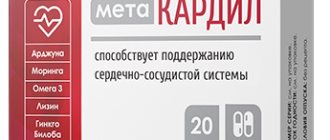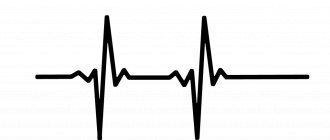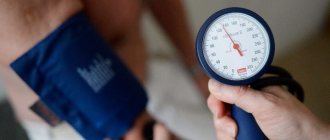Arterial hypertension affects more than 50% of the world's population. The risk of changes in the functioning of blood vessels and the heart increases with age. If in children and young people the indicators are almost always normal or slightly below average, then in men and women after 50 years of age, people with stable 120/80 are rarely found. In most cases, blood pressure levels tend to rise. This is facilitated by a decrease in the elasticity of the vascular walls, accumulated chronic disorders, changes in hormonal status and other factors.
Why is it necessary to reduce blood pressure?
Lowering blood pressure is a necessary part of the treatment of hypertension, which has various origins. This must be done not only to improve well-being, but also to eliminate dangerous conditions:
- crisis;
- arrhythmias;
- hypoxia;
- disturbances in the blood supply to the tissues of internal organs and the brain.
If you ignore high blood pressure readings, the risk of strokes, heart attacks, progression of angina and heart attacks increases. Everyone whose indicators are outside the normal range has to resort to drugs that normalize blood pressure:
- 120–140 mm/Hg: systolic (upper);
- 80–89 mm: diastolic (lower).
Blood pressure close to the lower limits is considered ideal. A tendency to periodically increase values may be the first sign of pathology. Factors provoking the development of the disease:
- stress;
- chronic systemic diseases;
- unfavorable heredity;
- congenital heart and vascular defects;
- disorders of the kidneys;
- unhealthy diet;
- smoking;
- obesity;
- disturbance of carbohydrate or lipid metabolism.
People with incipient or established hypertension often think that they have no health problems. High blood pressure may not show itself at first. As the pathology progresses, it causes sharp throbbing headaches. During an increase in pressure, vision impairment, tinnitus, nausea, and general weakness may occur. Without drug correction, it is not far from a serious attack and irreversible consequences.
Beta blockers: adjusting the rhythm of the heart muscle
Drugs in this group are prescribed if the patient has pathologies of the heart muscle. Beta blockers reduce the effect of adrenaline on the heart, causing the heart to beat faster, weaker, and as a result, blood pressure drops. Medicines are often prescribed to older people who have had a heart attack.
- "Metoprolol." Reduces heart rate, normalizes rhythm. The drug is of a prolonged nature: the hypotensive effect of the drug is not observed immediately, only after several days of use.
- "Carvedilol". An effective medicine for high blood pressure for older people reduces the symptoms of hypertension, reduces the intensity and frequency of angina attacks, and dilates blood vessels.
- "Nebivolol". Reduces blood pressure, reduces cardiac output, improves diastolic and systolic heart function.
- "Labetalol". Restores vascular tone, normalizes the functioning of the heart muscle.
When taking beta blockers, it is important to consider that they often cause excess weight. Another important point: by combining them with diuretics, you can increase the risk of developing diabetes.
My father boasted all his life that he “didn’t feel” the pressure of “160/100”. I went to work, went about my daily activities, and ignored the pills. The result is a heart attack. Now he strictly follows all doctors’ orders. Among all the medications that were prescribed to him, there is Coverdilol. Affordable, it is effective. Blood pressure decreased and normalized to “120/80”. Now we joke that at least we can go into space.
Anna P., Kaliningrad
How to use high blood pressure medications
People suffering from hypertension should not buy medications that normalize blood pressure on the advice of friends, pharmacists, or by their own choice. Medicines in this category are selected strictly individually. This is done by the attending physician based on the results of the examination. The type of tablets, their dosage, frequency of administration, and course duration are also determined separately for each patient. The age, stage of hypertension, the causes that caused it, and concomitant diseases are taken into account.
In most cases, patients require medication correction constantly. The doctor may prescribe one or more drugs with different principles of action. Over time, it may be necessary to increase the dosage of tablets. And as your physical condition improves, the amount of medication is reduced.
There are 6 groups of medications to normalize high blood pressure. They all have different mechanisms of action and are available by prescription.
Physiotens - a medicine with a minimum of side effects
Physiotens has a minimum of side effects. The most unpleasant symptoms include dry mouth and possible drowsiness. But most often it is possible to keep the pressure normal without side effects, or they are mild, which a hypertensive patient may not even be aware of.
Another feature of Physiotens is that it is approved for use in patients with bronchial asthma. In addition, the components included in the composition increase sensitivity to the hormone insulin. This means that the drug can be prescribed to patients with diabetes.
The main active ingredient here is moxodinine.
Calcium antagonists
By blocking the penetration of calcium ions into cells, these drugs cause a reflex relaxation of the muscle walls of blood vessels, reducing their tone. As a result of the expansion of the lumen of the arteries, the blood pressure decreases. Side effects of such drugs include: tachycardia, heart rhythm disturbances, dizziness. Popular tablets of this group:
- Dialtiazem;
- Verapamil;
- Norvasc.
The drugs effectively reduce blood pressure in various forms of hypertension, but do not combine well with other groups of antihypertensive drugs and have many contraindications.
Medicines for hypertensive patients: selection features
When prescribing drugs, it is important to take into account the nature of the pathology and the risk of developing side effects from a particular drug. The same applies to dosage: the age, weight of the patient, and the presence of chronic diseases influences. Most drugs have a prolonged, cumulative effect. You need to take them according to the schedule, at a certain time, without missing a single dose.
All high blood pressure pills for the elderly can be divided into several main groups:
- Diuretics.
- Beta blockers.
- Inhibitors.
- Calcium antagonists.
- Combined drugs.
Main purpose of diuretics
– rid the body of excess fluid and accumulated salts, the excess of which negatively affects the functioning of the heart muscle and blood circulation. Diuretics are usually taken in small dosages because they increase cholesterol levels. Medicines in this group are necessarily prescribed to patients who have problems with the adrenal glands and kidneys.
- Furosemide. It has a highly diuretic, but short-term effect. It is prohibited for use by persons suffering from renal failure.
- "Metolazone." A popular remedy for edema and high blood pressure. It is not recommended to use for a long time.
- "Amiloride." Effective in the early stages of hypertension in the elderly. Contraindicated in case of increased calcium levels in the blood.
- "Indapamide". Helps reduce blood pressure and remove excess fluid. Often prescribed to people with diabetes.
- "Veroshpiron" and "Aldakton". These modern medications for hypertension for the elderly reduce blood pressure without sudden changes, while providing a diuretic effect.
My mother is 78 years old and has suffered from high blood pressure for more than 20 years. There are a huge number of prescribed drugs. But when she feels that her blood pressure is rising, she immediately takes a Furosemide tablet - this is a kind of first aid. Therefore, we always keep Furosemide at hand, even in the pockets of our outerwear there is always a plate.
Olga Vasilyeva, Moscow
ACE inhibitors (angiotensin-converting enzyme)
Drugs that reduce the production of the enzyme that produces angiotensin, a hormone that provokes vascular spasms and a subsequent increase in blood pressure. They act quite gently, improve the outflow of excess fluid from the body, eliminating swelling. But they often provoke coughing attacks - this is their characteristic side effect. Common drugs:
- Zokardis;
- Captopril;
- Criminals
All products are available in the form of tablets of various dosages.
Inhibitors and their features
Inhibitors are modern hypertension medications for older women and men. The drugs in this group normalize the functioning of blood vessels, the heart muscle, and restore the water-salt balance in the body. In practice, it has been proven that drugs activate brain function and have a positive effect on the patient’s nervous system. Taking inhibitors is allowed for patients with renal pathologies. An important advantage of medications is that they have virtually no side effects.
- "Captopril." Improves blood supply to the myocardium with long-term use. Effective for early and middle stages of hypertension.
- "Enalapril." It is characterized by fast action (the result is noticeable within an hour). Eliminates symptoms of heart failure, normalizes blood pressure.
- "Fosinopril." It has a vasodilating effect, improves blood supply to the kidneys, and stabilizes blood pressure.
- "Ramipril." Promotes vasodilation, eliminates palpitations, normalizes mood, and increases vitality.
Drugs in this group are often prescribed in combination with diuretics to enhance the effectiveness of therapy.
We bought Enalapril for my grandmother instead of a more expensive analogue. I have been taking the drug for 3 months now, and there are obvious improvements. He takes pills every day at the same time. They say that Enalapril causes some side effects in the form of cough. Everything is fine with us, no unwanted effects were noticed.
Larisa K.
Exercises to lower blood pressure for the elderly
Staying physically active is a very important aspect. Moderate loads keep the walls of blood vessels toned, promote normal heart function and eliminate congestion. In this case, preference is given to so-called aerobic exercises or cardio exercises - walking in the park, jogging, climbing stairs, yoga and breathing exercises. You need to choose from this list in accordance with the age and condition of the elderly person.
An important principle is to control your heart rate when performing exercises. Traditionally, it is calculated using the formula: 220 - the patient’s age. Thus, for a 70-year-old patient, the number of heartbeats during exercise should not exceed 150 times per minute. If the pulse steadily reaches its maximum, the optimal solution is to switch to deep and slow breathing, while inhaling through the nose and exhaling through the mouth.
A healthy lifestyle and diet are a great help for normalizing blood pressure. But you shouldn’t rely only on them in adulthood - you should definitely consult a doctor to select reliable medications.
Associated symptoms
The increase in pressure is caused by the increased influence of blood on the walls of blood vessels during movement. Unfavorable external and internal factors can lead to such a problem.
High blood pressure is more than just a headache. Associated symptoms that make you feel worse include:
- feeling of heat in the body, especially on the face and neck;
- spatial coordination of the body, dizziness;
- numbness of the limbs, redness of the face;
- persistent nausea and even vomiting;
- increased sweating;
- difficulty breathing, shortness of breath.
If there are pressure surges and against the background of the above symptoms, an increase in body temperature, vomiting, clouding of consciousness, or blurred vision, you must immediately call an ambulance.
Pharmacotherapy of arterial hypertension in elderly patients
The issues of rational pharmacotherapy of arterial hypertension (AH) and the optimal choice of antihypertensive drugs are important and relevant for a variety of categories of patients, but they are of particular importance for patients who have a variety of concomitant conditions, diseases and risk factors. All this fully applies to elderly and senile patients who, in addition to hypertension, have a wide range of concomitant pathologies. Frequent concomitant diseases among them are coronary heart disease (CHD), chronic obstructive pulmonary disease (COPD), diseases of the gastrointestinal tract, thyroid pathology, metabolic syndrome, etc. These diseases significantly increase the risk of general and cardiovascular mortality, which requires improving the tactics of managing elderly patients [1, 2].
A rational choice of pharmacotherapy also requires taking into account a number of factors on which the choice of a particular class of drugs depends. In elderly and senile people, first of all, the features of the formation and pathogenesis of high blood pressure (BP) and the features of the pharmacokinetics and pharmacodynamics of drugs should be taken into account [3].
Features of hypertension in the elderly
Although the reasons leading to the development of hypertension are the same in all patients, regardless of age, in the elderly, during the aging process, additional prerequisites for the development of hypertension appear, such as hypoxic damage and age-related functional restructuring of the diencephalic-hypothalamic structures of the brain, age-related changes in the sympathoadrenal (SAS) and renin-angiotensin-aldosterone systems (RAAS); age-related decrease in elasticity, increased rigidity, as well as atherosclerotic changes in the aorta and large arteries; worsening dysfunction of the vascular endothelium and reducing its ability to produce vasodilating substances; ischemic changes in the kidneys and heart; deterioration of blood rheology, microcirculation and tissue metabolism; increase in body weight, decrease in physical activity, increase in the duration of bad habits.
There is a low concentration of plasma aldosterone, which correlates with the level of angiotensin and plasma renin activity. All this determines the characteristics and formation of the most common variant of hypertension in the elderly - isolated systolic hypertension (ISAH), which is characterized by an increase in the stiffness of the aorta and large arteries, a decrease in the damping role of the blood wave in large and small arteries, an increase in systolic blood pressure (SBP) and a decrease diastolic blood pressure (DBP). The prevalence of ISAH is 0.1% among persons under 40 years of age, 0.8% among those aged 40–49 years, 5% among those aged 50–59 years, 12.6% among those aged 60–69 years, and 23 .6% - aged 70–80 years. This increase in the number of patients with ISAH is associated with the fact that an increase in SBP occurs at least until the age of 80, while DBP after 50 years either remains at the same level or tends to decrease [2]. Data from the Framingham study indicate that in people of all age groups, the risk of developing cardiovascular complications (CHD, including myocardial infarction, stroke, heart failure, atherosclerosis of peripheral arteries) has close correlations, primarily with the level of systolic and not diastolic blood pressure. The risk of developing chronic heart failure during a 34-year follow-up was 2.3 times higher in men and 3.0 times higher in women when comparing groups of people with the lowest and highest systolic blood pressure.
In patients over 60 years of age, a peculiar form of hypertension may occur with frequent short-term, asymptomatic rises in blood pressure to high levels, which are alternated by a drop in blood pressure below normal values. Such episodes can occur either for no apparent reason or as a result of taking low doses of antihypertensive drugs. The quality of life in such patients deteriorates significantly, primarily due to the fear of waiting for the next rise or fall in blood pressure. Prescribing antihypertensive drugs, even in small doses, can lead to aggravation of the severity of hypotensive conditions. In the pathogenesis of this variant of hypertension, disorders of the autonomic nervous system at various levels associated with age-related degenerative changes play an important role.
Features of hypertension in the elderly are also “pseudohypertension”, associated primarily with increased vascular stiffness, “white coat hypertension”, increased blood pressure variability, as well as episodes of postprandial and orthostatic hypotension. Hypertension in elderly patients is often accompanied by metabolic disorders (dyslipidemia, diabetes mellitus, gout, obesity), the presence of which increases the overall risk of developing cardiovascular complications. The presence of left ventricular myocardial hypertrophy in elderly patients increases the risk of sudden death. The decline in glomerular filtration rate and kidney function with age requires dynamic monitoring of urea, creatinine and electrolyte levels.
Features of pharmacokinetics and pharmacodynamics of drugs in the elderly
With age, processes progress that significantly affect the bioavailability and, ultimately, the effectiveness of drugs. Of great importance are age-related changes in the gastrointestinal tract (hypokinesia of the stomach and intestines, atrophic changes in their mucous membrane, decreased blood flow), which ultimately lead to a slowdown in the rate of gastric emptying and a decrease in active absorption.
Decrease in muscle mass, total and percentage body water, plasma volume, albumin concentration and adipose tissue content, as well as age-related atherosclerotic changes in blood vessels also contribute to a decrease in the volume of distribution of water-soluble and fat-soluble substances. The rate of pharmacokinetic processes changes, determining both the rate of biotransformation of xenobiotics due to a decrease in the activity of liver enzymes and a decrease in its blood supply, and the rate of renal excretion of drugs. With age, the mass of the kidneys, the number of functioning glomeruli, the rate of renal blood flow (in patients over 70 years old it is 2 times lower than in middle-aged people) and glomerular filtration decrease.
Also, with age, the density of receptors, the dynamics of ion channels, the activity of enzyme systems responsible for the formation of the pharmacological effect on drugs change, homeostatic mechanisms are weakened, which can often lead to hypotonic states during antihypertensive therapy, hypoglycemia during treatment with hypoglycemic agents.
Principles of antihypertensive therapy in the elderly
All of the above factors determine the features of the approach and principles of antihypertensive pharmacotherapy in elderly patients:
- when selecting adequate doses of antihypertensive drugs, it is necessary to monitor blood pressure in both sitting and standing positions;
- A sharp decrease in blood pressure should be avoided, especially with the appearance and/or worsening of heart failure;
- It is advisable to begin treatment with monotherapy with any antihypertensive drug in a small dose, which is gradually, at intervals of several weeks, increased until a sufficient antihypertensive effect is achieved, which avoids a rapid decrease in blood pressure that is poorly tolerated by elderly patients and orthostatic disorders, accompanied by worsening cerebral and renal failure , on the other hand, makes it possible to gradually find the minimum effective dose and continue treatment with a low probability of side effects;
- individual selection of drugs for initial treatment should be made taking into account concomitant pathology, individual pathophysiological characteristics of hypertension, indications and limitations for certain groups of drugs;
- preference should be given to long-acting drugs with the most optimal metabolic profile;
- You should not use drugs that can cause orthostatic hypotension (α-blockers) and impaired cognitive function (central α-2-adrenergic agonists).
Particular attention in the European and national recommendations of the latest revision is paid to the target level of blood pressure, which for elderly patients with SBP more than 160 mm Hg. Art. is 150–140 mmHg. Art. (grade of recommendation I, level of evidence A). For elderly patients under 80 years of age who lead an active lifestyle, if treatment is well tolerated, the target SBP level may be less than 140 mmHg. Art. (class of recommendation IIb, level of evidence C) [4, 5].
Choice of antihypertensive drugs in elderly patients
Modern cardiology has a large number of modern antihypertensive drugs, the rational use of which, of course, leads to a reduction in the incidence of adverse outcomes. The issues of optimal and rational choice of a drug (drug), taking into account the peculiarities of their action, are of particular relevance in the primary health care system, since the further prognosis for the patient depends on well-chosen antihypertensive therapy in outpatient clinics. Recommendations summarizing the evidence base for all classes of antihypertensive drugs can be of great help to the practitioner at the stage of choosing pharmacotherapy.
The guidelines for the treatment of hypertension recommend five main classes of drugs that have a convincing evidence base for their effect on prognosis. These are angiotensin-converting enzyme inhibitors (ACEIs), angiotensin II receptor blockers (ARBs), calcium antagonists (CAs), beta-blockers (BABs) and diuretics, which can be prescribed either as monotherapy or as part of combination therapy. All these classes of antihypertensive drugs can be used in elderly patients with hypertension, however, in ISAH, diuretics and calcium antagonists have an advantage (class of recommendations I, level of evidence A) [4, 5].
Of the diuretics, the optimal drug that meets modern requirements is Indapamide retard, which belongs to the thiazide-like diuretics. Its beneficial effects have a large evidence base, which indicates that the drug not only affects blood pressure levels and the condition of target organs, but also reduces mortality rates [6–12]. Indapamide retard is distinguished by good tolerability of treatment and a low incidence of side effects, which is crucial in the treatment of the elderly both from the point of view of maintaining quality of life and from the point of view of ensuring adherence to therapy. A number of studies have shown a lower incidence of hypokalemia, the absence of a negative effect on carbohydrate and lipid metabolism in comparison with classical thiazide diuretics, as well as generally data on good tolerability of treatment with Indapamide retard.
Calcium antagonists
Of the calcium antagonists (CAs), clinical use has mainly been achieved by those that have competitive antagonism of voltage-dependent slow L-type calcium channels. First-generation AKs with a short half-life are well known and have long been used in clinical practice: nifedipine, verapamil, diltiazem. The II generation includes drugs with a long half-life, which are divided into two subclasses: IIa - new dosage forms of prototype drugs with slow release; IIb - drugs that differ from the prototypes in chemical structure and have a slow release. The third generation includes ultra-long-acting dihydpyridine derivatives - amlodipine, lacidipine and lercanidipine [13].
The advantage of all AKs is good tolerability and a wide range of pharmacological effects: antianginal, antihypertensive, cytoprotective, antithrombotic, and therefore they are widely used in cardiological practice.
One of the new third-generation AKs is lercanidipine (the original drug Lerkamen®), which, due to its high lipophilicity and vascular selectivity, is capable of providing a gradually developing and long-lasting antihypertensive effect when taken once a day. Unlike other dihydropyridine AKs, it has very high selectivity for vascular smooth muscle, exceeding its affinity for other types of smooth muscle. The relaxing activity of lercanidipine on the smooth muscle of the rat aorta was 177 times higher than that in the bladder, and 8.5 times higher than in the intestine (for comparison, nitrendipine has the same activity against the three types of tissue tested). Moreover, the concentration ratio required to inhibit contractility by 50% in cardiac/vascular tissue was higher for lercanidipine (730) than for lacidipine (193), amlodipine (95), felodipine (6) and nitrendipine (3) [14] .
The effectiveness of modern antihypertensive drugs provides the opportunity to improve the functional and structural state of target organs. The organoprotective properties of lercanidipine include a reduction in the mass of the left ventricular myocardium [15, 16], nephroprotection [17], and angioprotection [18–20]. It is also important that lercanidipine is metabolically neutral and even has a positive effect on lipid metabolism in patients with mild and moderate hypertension and in patients with type 2 diabetes mellitus (DM) [21].
The drug is effective in patients with mild, severe or resistant hypertension (as part of combination therapy) [22], with isolated systolic hypertension, in postmenopausal women with hypertension [23], in patients with type 2 diabetes [21, 24] , as well as in elderly patients (Table) [25–29]. Moreover, lercanidipine in elderly people over 60 years of age is not inferior in effectiveness and tolerability to two other dihydropyridine AKs - amlodipine and lacidipine [26].
The pharmacokinetics of lercanidipine in the elderly and in patients with mild to moderate renal or hepatic dysfunction are little different from those in the general population. No dose adjustment of lercanidipine is required during the initial phase of treatment in elderly patients and patients with mild to moderate renal or hepatic impairment, although initiation of treatment and dose titration in them should be carried out with caution. According to clinical studies, lercanidipine is well tolerated [19, 29, 30]. Most adverse reactions when taking the drug are associated with vasodilation. In the two largest studies (9059 and 7046 patients with mild and moderate hypertension), adverse reactions were noted in 1.6% and 6.5% of patients receiving lercanidipine at a dose of 10 or 20 mg/day, respectively. The most common adverse reactions were: headache (0.2% and 2.9%), swelling of the ankles (0.4% and 1.2%), feeling hot (1.0% and 1.1%) [19 , thirty].
It is recommended to exercise special caution when prescribing it to patients with sick sinus syndrome (unless a pacemaker is implanted). The risk of drowsiness and fatigue when taking lercanidipine is small, but should be taken into account when driving or servicing potentially dangerous machinery.
Conclusion
The calcium antagonist lercanidipine, due to its high lipophilicity and vascular selectivity, is capable of providing a gradually developing and long-lasting antihypertensive effect when taken once a day. The drug is effective in patients with hypertension of different categories, including the elderly. Lercanidipine is as effective as many other current antihypertensive drugs, and the good tolerability profile may contribute to better adherence to long-term antihypertensive therapy with this drug.
This article is an independent opinion piece and is not sponsored.
Literature
- Shalnova S. A., Balanova Yu. A., Konstantinov V. V. et al. Arterial hypertension: prevalence, awareness, use of antihypertensive drugs and the effectiveness of treatment among the population of the Russian Federation // RKZh. 2006; 4:45–50.
- Fletcher A. Epidemiology of Hypertension in the elderly // J Hypertens. 1994; 12 (Suppl. 6).
- Pharmacotherapy of chronic cardiovascular diseases: Guide / Ed. Morozova T. E. 2nd edition, revised. and additional M., 2011. 392 p.
- 2013 ESH/ESC Guidelines for the management of arterial hypertension: the Task Force for the management of arterial hypertension of the European Society of Hypertension (ESH) and of the European Society of Cardiology (ESC) // Journal of Hypertension. 2013; 31(7):1281–1357.
- Diagnosis and treatment of arterial hypertension. Clinical recommendations of the Ministry of Health of the Russian Federation, 2013. https://cardioweb.ru/klinicheskie-rekomendatsii.
- Gosse Ph., Sheridan D., Zannad F. et al. Regression of left ventricular hypertrophy in hypertensive patients treated with indapamide SR 1.5 mg versus enalapril 20 mg: the LIVE Study // J Hypertension. 2000; 18: 1465–1475.
- Kostis JB, Wilson AC, Fruedenberger RS Long term effect of diuretic based therapy on fatal outcomes in subjects with isolated systolic hypertension with and without diabetes // Am J Cardiol. 2005; 95:29–35.
- Marre M., Garcia-Puig J., Kokot F. et al. Equivalence of indapamide SR and enalapril on microalbuminuria reduction in hypertensive patients with type 2 diabetes: the NESTOR study // J Hypertension. 2004; 22: 1613–1622.
- Marre M., Garcia-Puig J., Kokot F. et al. Efficacy of indapamide SR compared with enalapril in elderly hypertensive patients with type 2 diabetes // Am J Hypertension. 2007; 20: 90–97.
- Peters R., Beckett N., Forette F., Tuomilehto J., Clarke R., Ritchie C. et al. Incident dementia and blood pressure lowering in the Hypertension in the Very Elderly Trial cognitive function assessment (HYVET-COG): a double-blind, placebo controlled trial // Lancet Neurol. 2008; 7:683–689.
- The HYVET Study Group. Treatment of Hypertension in Patients 80 Years of Age or Older // N Engl J Med. 2008; 358.
- Weidmann P. Metabolic profile of indapamide sustained-release in patients with hypertension // Drugs Safety. 2001; 24: 1155–1165.
- Morozova T. E., Vartanova O. A. Lercanidipine is a third-generation dihydropyridine with ultra-long action // Consillium medicum. 2011, No. 10, vol. 13, p. 22–29.
- Bang LM, Chapman TM, Goa KL Lercanidipine: a review of efficacy in arterial therapy // Drugs. 2003; 63(22):2449–2472.
- Fogari R., Mugellini A., Corradi L. et al. Efficacy of lercanidipine vs losartan on left ventricular hypertrophy in hypertensive type 2 diabetic patients // J Hypertens. 2000; 18 (Suppl. 2): S65.
- S'anchez A., Sayans R., Alvarez JL et al. Left ventricular hypertrophy regression after a short antihypertensive treatment with lercanidipine vs. enalapril // Fourth European Meeting on Calcium Antagonists. 1999, Oct 27–29; Amsterdam.
- Dalla Vestra M., Pozza G., Mosca A., Grazioli V, Lapolla A., Fioretto P., Crepaldi G. Effect of lercanidipine on the level of albumin excretion in hypertensive patients with type 2 diabetes mellitus in comparison with ramipril // Medicine emergency conditions. 2006, 2 (3).
- Cargnoni A., Benigno M., Ferrari F. et al. Effects of lercanidipine and its enantiomers on ischemia and repefusion-1 // J. Cardiovascular. Pharmacol. 1997; 29 (suppl. 1): S48-S62.
- McClellan KJ, Jarvis B. Lercanidipine. A review of its use in hypertension // Drugs. 2000; 60(5):1123–1140.
- Rossoni G., Bernareggi M., De Gennaro Colonna V. et al. Lercanidipine protects the heart from low–flow ischemia damage and antagonizes the vasopressor activity of endothelin-1 // J. Cardiovascular. Pharmacol. 1997; 29 (suppl. 1): S41-S47.
- Notarbartolo A., Rengo F., Scafidi V. et al. Long-term effects of lercanidipine on the lipoprotein and aholipoprotein profile of patients with mild to moderate essential hypertension // Curr Ther Res. 1999. V. 60 (4): S 228–236.
- Paterna S., Licata A., Arnone S. et al. Lercanidipine in two different dosage regimens as a sole treatment for severe essential hypertension // J Cardiovasc Pharmacol. 1997; 29(Suppl. 2): S50–53.
- Herrera J., Ghais Z., Gonzalez L. Antihypertensive treatment with a calcium channel blocker in postmenopausal women: prospective study in a primary health care setting // J Hypertens. 2002; 20(Suppl. 4): S162.
- Barrios V., Navarro A., Esteras A. et al. Antihypertensive efficacy and tolerability of lercanidipine in daily clinical practice. The ELYPSE study // Blood Press. 2002; 11 (2): S. 95–100.
- Barbagallo M., Barbagallo Sangiorgi G. Efficacy and tolerability of lercanidipine in monotherapy in elderly patients with isolated systolic hypertension // Aging Clin Exp Res. 2000; 12 (5): S. 375–379.
- Leonetti G., Magnani B., Pessina AC et al. Tolerability of longterm treatment with lercanidipine versus amlodipine and lacidipine in elderly hypertensives // Am J Hypertens. 2002; 15(11):S932–940.
- Romito R., Pansini MI, Perticone F. et al. Comparative effect of lercandipine lercandipine, felodipine and nifedipine GITS on blood pressure and heart rate in patients with mild to moderate arterial hypertension: the Lercandipine in Adults (LEAD) study // J Clin Hypertens. 2003; 5(4):S249–253.
- Cherubini A., Fabris F., Ferrari E. et al. Comparative effects of lercanidipine, lacidipine and nifidepine GITS on blood pressure and heart rate in elderly hypertensive patients: the ELderly and LErcanidipine (ELLE) study // Arch Gerontol Geriatr. 2003. V. 3. S203–212.
- Borghi S., Prandin MG, Dormi A. et al. The use of lercanidipine can improve the individual tolerability in dihydropyridine calcium blockers in hypertensive patients // J. Hypertension, 2000; 18 (suppl. 2): S155—S156 (abstract).
- Dedova I. S., Preobrazhensky D. V., Sidorenko B. A., Tarykina E. V., Shaipova A. M. Lercanidipine is a new third-generation calcium antagonist: clinical pharmacology and experience in the treatment of arterial hypertension // Russian Medical magazine. 2006. No. 20, p. 1411–1417.
T. E. Morozova 1, Doctor of Medical Sciences, Professor OA Vartanova, Candidate of Medical Sciences MB Lukina
GBOU VPO First Moscow State Medical University named after. I. M. Sechenova Ministry of Health of the Russian Federation, Moscow
1 Contact information
Preventing headaches
To prevent headaches and increased upper and lower blood pressure, you must follow the rules of prevention:
- Maintaining a healthy lifestyle is mandatory.
- Eat right (exclude salty, fatty, spicy, fried foods), avoid excess body weight.
- It is always necessary to treat infectious and inflammatory diseases in a timely manner and prevent them from becoming chronic.
- Excessive physical activity is not allowed.
- It is best to avoid bad habits.
- Moderate exercise keeps blood vessels in good condition.
Activities that strengthen the immune system are no less important. Hardening the body, gymnastics, and vitamins allow you to resist the effects of unfavorable factors.
Long-acting drugs
In case of arterial hypertension of 2-3 degrees, elderly people are prescribed constant therapy with long-acting drugs. They are more convenient to use - you only need to take 1-2 times a day, they have a milder effect and a cumulative effect. After 2-3 weeks of constant use, stabilization of the condition and absence of pressure surges are observed.
The mechanism of action of the drugs is based on blocking angiotensin receptors, a powerful vasoconstrictor hormone that is produced in every body. In this case, the patient is not at risk of sudden drops in pressure, dizziness and weakness:
- The drug is well tolerated by most patients, side effects occur in 1% of cases;
- Provides a sustainable effect throughout the day - it is enough to take once a day before meals;
- Does not require an accumulation effect - begins to act within 6 hours.
The only significant drawback of drugs in this group is their high cost.
Treatment of high heart pressure
It is worth remembering that the causes and treatment of high heart pressure are absolutely individual for each organism. Treatment should begin with a comprehensive diagnosis of the whole organism. First of all, contact a cardiologist and undergo the appropriate examinations and tests. You may need help from other specialists.
The main task in the treatment of hypertension is to identify the causes that provoke high blood pressure and eliminate or minimize them.
At the local level, the primary means of combating high blood pressure include taking medications that normalize blood pressure. Also, the primary task of a person suffering from hypertension is to establish a normal daily routine, proper rest, minimizing stress, walking in the fresh air, proper nutrition, giving up bad habits, and physical activity.
Diet is another effective way to reduce blood pressure
A diet for high blood pressure in old age is comparable to the effect of long-acting medications: if the patient is disciplined and carefully monitors the diet, it can bring stable results.
At the same time, it does not require large investments and exotic products; you can follow the recommendations even on a very modest budget:
- The first thing to do is limit your salt intake. After all, the sodium contained in it helps to increase blood pressure and remove potassium from the body, which is necessary for the functioning of the heart. Please note that spices are not prohibited - pepper, coriander, parsley will help eliminate the effect of bland food and taste hunger.
- The No. 1 enemy for older people is cholesterol. A lot of it is found in the yolk of eggs, chicken skin and fatty, red meat. It is better to reduce the consumption of these products to a minimum and give preference to white meat - chicken breast, rabbit, and sea fish. The unsaturated fatty acids it contains displace cholesterol from biochemical processes and help increase the elasticity of blood vessels.
- What foods reduce blood pressure in old age? Sometimes you can find whole lists: bananas, avocados, leafy vegetables, asparagus, beets and many others. The fact is that they are all rich in potassium, a microelement that supports the proper functioning of blood vessels, the heart and the nervous system.
Thus, the diet to reduce blood pressure is simple: you need to exclude salty, fried and pickled foods, minimize the amount of salt and give up fatty meat. An abundance of vegetables, fruits and grain products will help maintain normal blood pressure.











